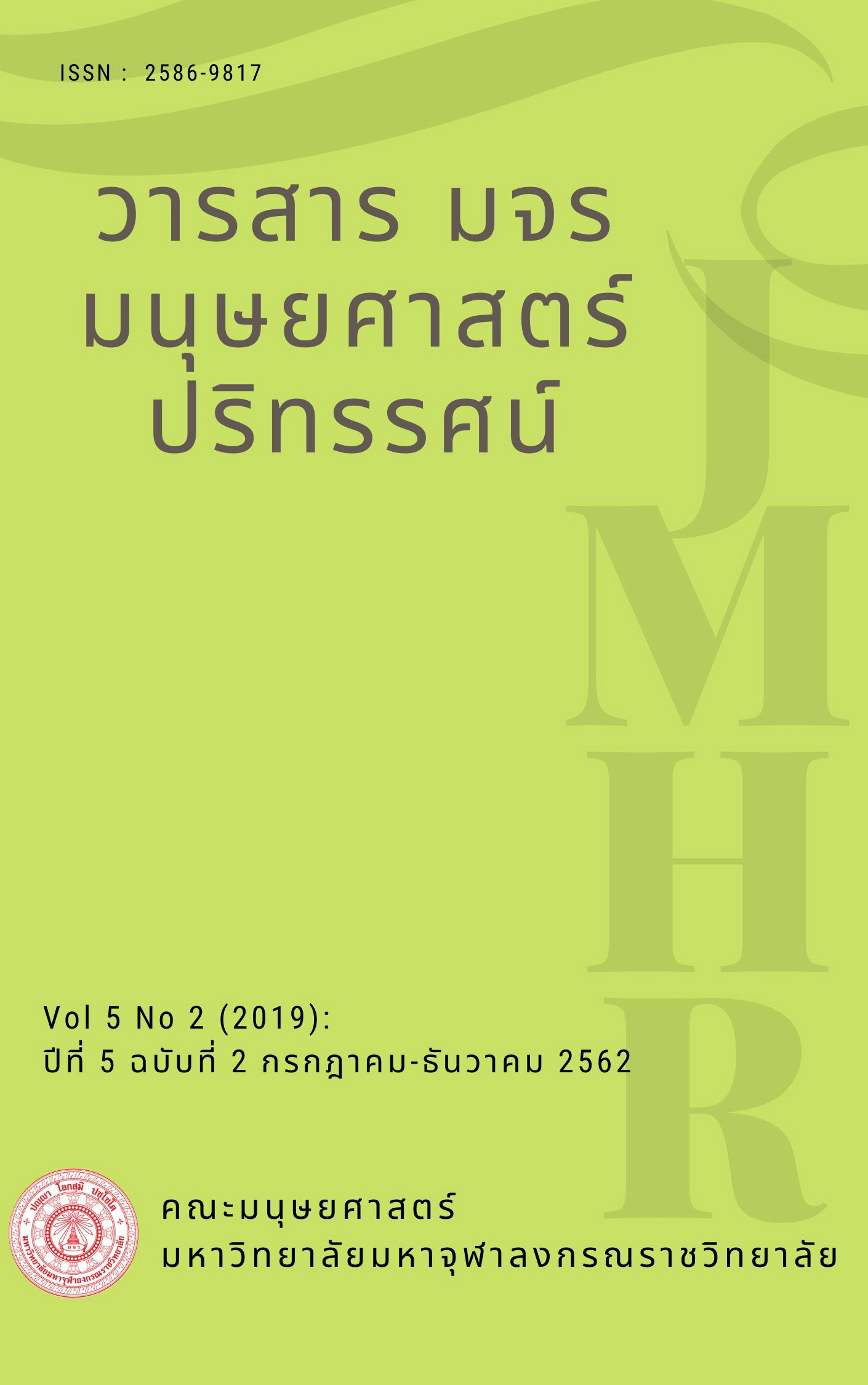ศึกษาความสัมพันธ์ระหว่างพรหมวิหาร 4 กับความผาสุกทางวิญญาณ ของนักศึกษาวิทยาลัยอาชีวศึกษาจุลมณีในจังหวัดศรีษะเกษ
คำสำคัญ:
ความสัมพันธ์, พรหมวิหาร, ความผาสุกบทคัดย่อ
บทความวิจัยนี้ เป็นส่วนหนึ่งของวิทยานิพนธ์ เรื่อง ศึกษาความสัมพันธ์ระหว่างพรหมวิหาร 4 กับความผาสุกทางวิญญาณของนักศึกษาวิทยาลัยอาชีวศึกษาจุลมณีในจังหวัดศรีษะเกษมีวัตถุประสงค์ของการศึกษาคือ 1) เพื่อศึกษาระดับความผาสุกทางวิญญาณ ของนักศึกษาวิทยาลัยอาชีวศึกษา จุลมณีศรีษะเกษ ตำบลดูน อำเภอกันทรารมย์ จังหวัดศรีสะเกษ 2) เพื่อศึกษาความสัมพันธ์ระหว่างพรหมวิหาร 4 และความผาสุกทางวิญญาณของนักศึกษา วิทยาลัยอาชีวศึกษาจุลมณีศรีษะเกษ ตำบลดูน อำเภอกันทรารมย์ จังหวัดศรีสะเกษ เครื่องมือที่ใช้ในการเก็บรวบรวมข้อมูล คือ แบบสอบถามซึ่งประกอบไปด้วย ข้อมูลทั่วไปของผู้ตอบแบบสอบถาม แบบสอบถามปัจจัยด้านพรหมวิหาร 4 และปัจจัยด้านความผาสุกทางวิญญาณสถิติที่ใช้ในการวิเคราะห์ข้อมูลประกอบด้วย การแจกแจงความถี่ (Frequency Distribution) ค่าร้อยละ (Percentage) ค่าเฉลี่ย(Mean) ค่าเบี่ยงเบนมาตรฐาน (Standard Deviation) การทดสอบความแตกต่างในระดับการรับรู้เกี่ยวกับปัจจัยด้านพรหมวิหาร 4 และปัจจัยด้านความผาสุกทางวิญญาณของนักศึกษาวิทยาลัยอาชีวศึกษาจุลมณีศรีสะเกษ ทดสอบค่าที (t-test) การทดสอบความแปรปรวน (F-test) แบบ One Way ANOVA และวัดความสัมพันธ์ของตัวแปรปัจจัยด้านพรหมวิหาร 4 และ ตัวแปรปัจจัยด้านความผาสุกทางวิญญาณด้วยการใช้สถิติสัมประสิทธิ์สหสัมพันธ์ของเพียร์สัน (Pearson’s Correlation Coefficient)
ผลการวิจัยพบว่า ก.) ความแตกต่างของระดับความผาสุกทางจิตวิญญาณ จำแนกตามข้อมูลส่วนบุคคล พบว่า นักศึกษาวิทยาลัยอาชีวศึกษาจุลมณีศรีสะเกษ ที่มีเพศ อายุ พี่น้อง ผลการศึกษา และรายได้ต่อเดือนครอบครัว แตกต่างกัน ไม่ได้มีระดับความผาสุกทางวิญญาณ แตกต่างกัน อย่างมีนัยสำคัญทางสถิติที่ .05 ข.) ความสัมพันธ์ระหว่างพรหมวิหาร 4 กับระดับความผาสุกทางจิตวิญญาณ พบว่า นักศึกษาวิทยาลัยอาชีวศึกษาจุลมณีศรีสะเกษมีระดับพรหมวิหาร 4 เมตตา กรุณา มุทิตา และอุเบกขา สัมพันธ์กับระดับความผาสุกทางวิญญาณทั้ง 3 ด้านในระดับสูงมาก อย่างมีนัยสำคัญทางสถิติที่ระดับ .01
เอกสารอ้างอิง
ดุษฎี โยเหลา และคณะ. (2553). รายงานฉบับสมบูรณ์ โครงการ การสร้างเครื่องมือประเมินและตัวชี้วัดระดับการพัฒนา จิตวิญญาณสำหรับบุคลากรด้านสาธารณสุข. สืบค้น 21 มีนาคม 2560 จาก http://www.thaisisf.org
พัชนี สมกำลัง. (2556). จิตวิญญาณของผู้นำทางการพยาบาลฟลอเรนซ์ ไนติงเกล. กรุงเทพมหานคร: จุฬาลงกรณ์ มหาวิทยาลัย.
ประเวศ วะสี. (2550). วิถีมนุษย์ในศตวรรษที่ 21 ศูนย์หนึ่งก้าว. (พิมพ์ครั้งที่ 4). กรุงเทพมหานคร: สวนเงินมีมา.
สิวลี ศิริไล. (2555). จริยศาสตร์สำหรับพยาบาล. (พิมพ์ครั้งที่ 12). กรุงเทพมหานคร: จุฬาลงกรณ์มหาวิทยาลัย.
พระธรรมปิฏก (ป.อ. ปยุตฺโต). (2541). พุทธธรรม. กรุงเทพมหานคร: มหาจุฬาลงกรณราชวิทยาลัย.
อุทุมพร มาลัยทอง. (2549). การรับรู้การสร้างเสริมสุขภาวะทางจิตวิญญาณของหัวหน้าหอผู้ป่วย. (วิทยานิพนธ์พยาบาลศาสตรมหาบัณฑิต สาขาวิชาการบริหารการพยาบาล), บัณฑิตวิทยาลัย มหาวิทยาลัยนเรศวร).
วาสนา เกษมสุข. (2545). ความผาสุกของผู้ดูแลเด็กพัฒนาการล่าช้าที่มารับการรักษาที่ศูนย์ส่งเสริมพัฒนาการเด็กภาคเหนือ. (วิทยานิพนธ์ศิลปศาสตรมหาบัณฑิต สาขาวิชาสาธารณสุขศาสตร์, บัณฑิตวิทยาลัย มหาวิทยาลัยเชียงใหม่).
สุพิศ สงนวล. (2545). ประสบการณ์การเยียวยาด้านจิตวิญญาณของผู้ป่วยมะเร็งที่ได้รับรังสีรักษาที่มีความผาสุกทางจิตวิญญาณ. (ปริญญานิพนธ์ พยาบาลศาสตรมหาบัณฑิต สาขาวิชาการพยาบาลผู้ใหญ่, บัณฑิตวิทยาลัย มหาวิทยาลัยสงขลานครินทร์).
พระมหาสมชาย สิริจนฺโท. (2547). พุทธธรรมเพื่อการพัฒนาคุณภาพตามคุณภาพแนวทางของพระเทพวรคุณ (สมาน สุเมโธ). (วิทยานิพนธ์พุทธศาสตรมหาบัณฑิต, บัณฑิตวิทยาลัย : มหาวิทยาลัยมหาจุฬาลงกรณราชวิทยาลัย).
ปิยะมาศ ยินดีสุข. (2548). การศึกษาเพื่อพัฒนาสุขภาวะทางจิตวิญญาณของนักเรียนโรงเรียนวิถีพุทธ. (วิทยานิพนธ์ครุศาสตรมหาบัณฑิต สาขาวิชาพัฒนศึกษา, บัณฑิตวิทยาลัย จุฬาลงกรณมหาวิทยาลัย).
นุสรา นามเดช และคณะ. (2545). ความสุขของนักศึกษาพยาบาล วิทยาลัยพยาบาลบรมราชชนนีสระบุรี (รายงานการวิจัย). วิทยาลัยพยาบาลบรมราชชนนีสระบุรี.
Compton. (2001). The Optimal Personality. Artst, Sage, or Saint.
Brown; and Lent. (2000). Psychological Bulletin.
Fisher, J., &Brumley, D. (2008). Nurses’ and carers’ spiritual well-being in the workplace. Australian Journal of Advanced Nursing. 25(4), 49-57.
Blazer; and Palmore. (1976). Ethics &issues : In contemporary nursing.
Hungelmann, J.; et al. (1996). Focus on spiritual well-being harmonious interconnectedness of mind-body-spirit. Use of the JAREL spiritual well- beingscale. Geratric Nursing. 17(6), 262-266.






